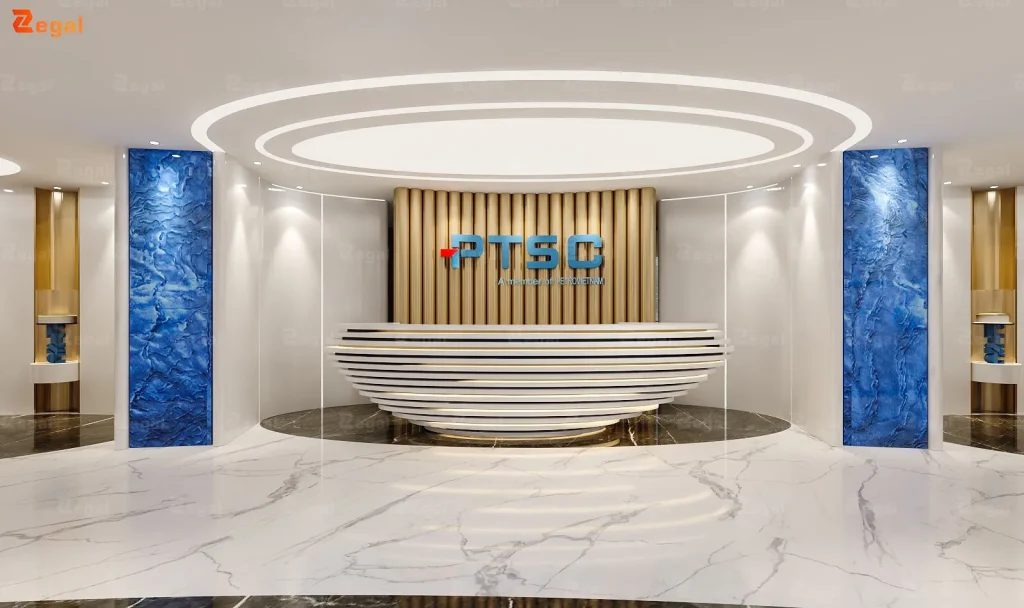When it comes to interior design, we often think immediately of wall colors, materials, and space layout. But there is one subtle element that defines the overall perception of a space—and it’s often overlooked: lighting. And no, just installing a few lights is not enough—indoor lighting distribution is a whole story of emotion, functionality, and aesthetics.
1. What is indoor lighting distribution and why is it important?
The concept of “indoor lighting distribution” in lighting design refers to the process of organizing a lighting system based on the function, mood, and specific usage needs of each interior space. This aims to achieve three main goals:
- Meet the functional lighting needs.
- Enhance spatial aesthetics and depth.
- Optimize energy efficiency.
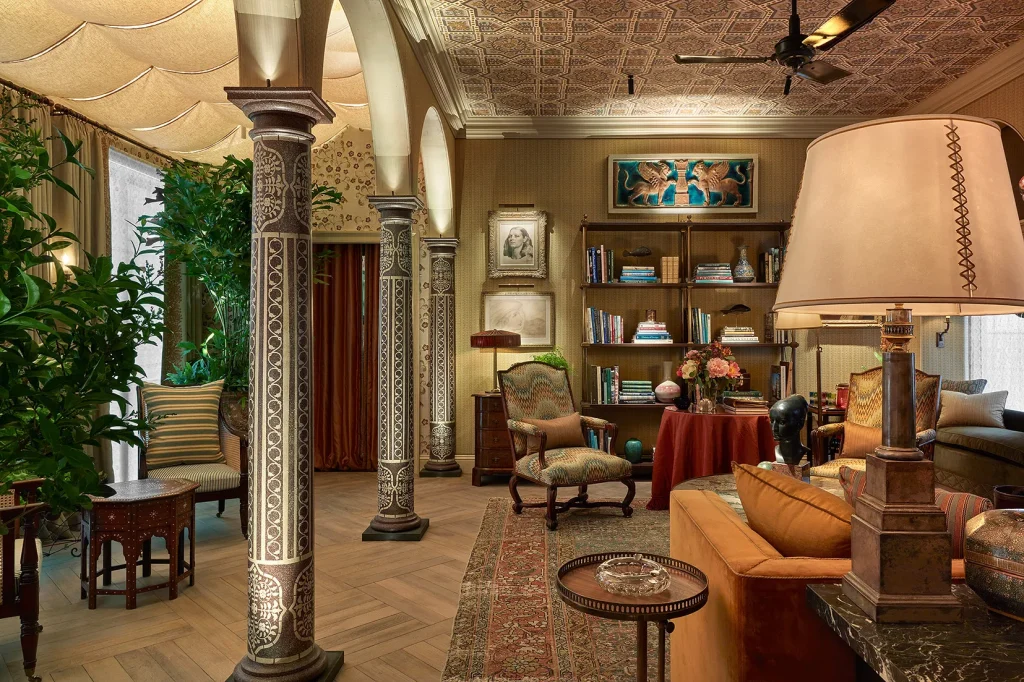
In professional lighting design, distribution involves more than the number of fixtures. It includes light direction, color temperature (CCT), color rendering index (CRI), illuminance level (lux), light intensity distribution (luminance), and especially, the transitions between light and dark zones (lighting hierarchy).
2. Golden principles in lighting distribution
2.1 Function-Oriented Design
A classic principle in lighting is that light must serve life’s functions. You can’t use cool white light at 6000K in a bedroom—a space that needs a relaxing 2700K tone. Likewise, a single ceiling light in a kitchen won’t cut it—a space that requires at least 500 lux for safe food preparation.
| Space | Recommended color temperature | Recommended illuminance (lux level) |
| Bedroom | 2700K – 3000K | 100 – 200 lux |
| Living room | 3000K – 4000K | 200 – 300 lux |
| Kitchen | 4000K – 5000K | 500 – 700 lux |
| Home office | 5000K trở lên | 500 – 1000 lux |
2.2 Layered Lighting

Layered lighting is more than a design principle—it’s a way of thinking that brings depth to space. A room lit only by a ceiling light becomes flat and emotionless. When you add under-cabinet lights, floor uplighting, and spotlights, the space begins to form a visual rhythm.
- Ambient lighting: provides general illumination and visibility throughout the room.
- Task lighting: focuses on specific areas like a desk or kitchen counter.
- Accent lighting: highlights architectural features, materials, or decorations.
- Decorative lighting: expresses personality and aesthetics—such as pendant art lights or wall sconces.
3. Understanding lighting: CCT, CRI, and Illuminance
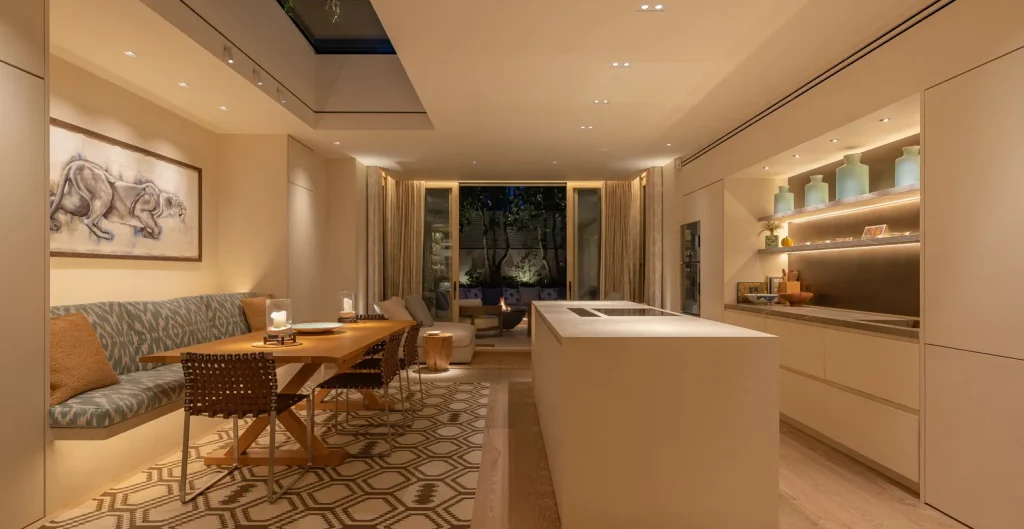
In interior lighting design, three key factors to understand in order to effectively distribute lighting are Color Temperature (CCT), Color Rendering Index (CRI), and Illuminance (lux). These are the foundation for choosing the right light, for the right location, and the right purpose.
3.1 Color Temperature (CCT)
Color temperature (CCT) reflects the hue of light perceived by the human eye. Low CCT values create a warm yellowish light that brings comfort and intimacy. Higher CCTs produce cold white light, ideal for focus-demanding areas.
- < 3000K: warm light—ideal for bedrooms, dining areas, or reading corners.
- 3500K – 4100K: neutral white—suitable for living rooms, hallways, or shared spaces.
- 5000K: cool white—used in workspaces, garages, storage rooms, or studios.
3.2 Color Rendering Index (CRI)
The Color Rendering Index (CRI) measures how accurately a light source displays the true color of an object. The higher the CRI, the more “natural” the colors appear—similar to how they would look under natural sunlight.

- CRI ≥ 80: sufficient for most daily living spaces.
- CRI ≥ 90: essential for color-critical areas like design workspaces, showrooms, or rooms with natural materials such as wood and stone.
3.3 Illuminance
Illuminance refers to the amount of light that falls on a surface, measured in lux. It directly affects your ability to see clearly, read, work, or safely move around.
- 100 – 200 lux: suitable for hallways, bedrooms, or relaxation zones.
- 300 – 500 lux: ideal for living rooms, dining areas, or common spaces.
- ≥ 500 lux: necessary for kitchens, workspaces, or areas requiring focus and accuracy.
4. Distributing light by space – practical strategies
Every area in your home serves a distinct function and emotional purpose. Therefore, lighting distribution should go beyond “just enough” and aim to create the right atmosphere for each activity and moment.
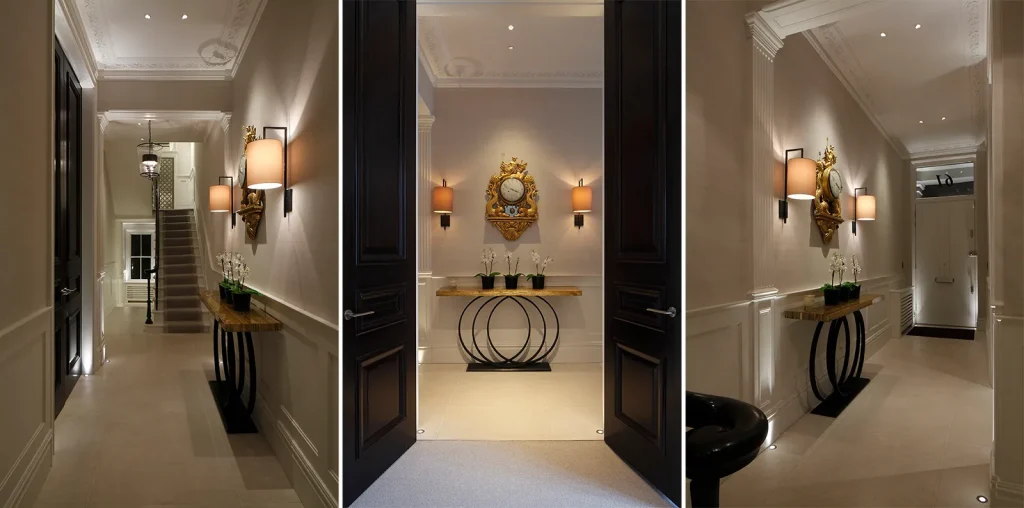
4.1 Living Room – The main stage of lighting
The living room is for welcoming guests, family gatherings, and expressing personal style. Therefore, lighting here needs to be flexible, layered, and easy to adjust.
- Use recessed ceiling lights arranged according to spatial layout to create even ambient lighting and avoid harsh shadows.
- Combine with cove lighting or wall washers to soften the atmosphere and create more natural highlights.
- Add floor or table lamps around sofas and coffee tables to enhance coziness in the evenings.
- For artwork or decor, install spotlights to draw attention and add visual depth.
4.2 Kitchen – A workspace that requires precision
Lighting in the kitchen goes beyond aesthetics—it must be safe and precise for food prep tasks.
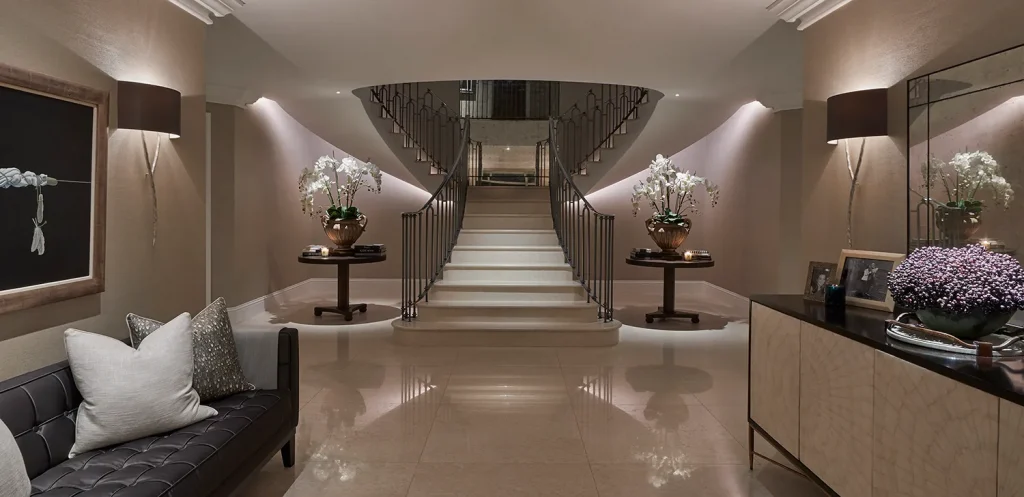
- Install ceiling lights with neutral white tones (4000K – 5000K) to reveal true food and surface colors.
- Use under-cabinet LED strips to directly illuminate the countertop, avoiding shadows caused by the body.
- Opt for CRI ≥ 85 to distinguish between raw and cooked food more clearly.
- For kitchen islands, use pendant lights or track lights for both functionality and aesthetic impact.
4.3 Bedroom – Soft lighting for a relaxed mood
Bedrooms don’t need to be too bright, but lighting must be soft, adjustable, and calming after a long day.

- Use warm light below 3000K to create a restful environment and promote better sleep.
- Replace ceiling lights with cove lighting, wall-mounted fixtures, or bedside lamps with fabric shades.
- Install dimmers or separate switches for bedside lamps to control brightness to match mood and time.
- For reading, use wall-mounted or clip-on lights with adjustable angles.
4.4 Workspace – Light that fuels concentration
Workspaces require lighting that enhances concentration, avoids eye strain, and supports productivity.
- Choose cool white light (≥ 5000K) to stay alert and boost mental activity.
- Place desk lamps with adjustable arms and anti-glare covers on the opposite side of your dominant hand.
- Combine with even ceiling or pendant lighting to avoid screen glare.
- Ensure CRI ≥ 90 for tasks involving design, printing, or color evaluation.

5. Common lighting distribution mistakes
Lighting is a fundamental element in interior design, yet many homes—even well-designed ones—still fall short in lighting distribution.
These mistakes affect visual experience, emotional tone, and day-to-day comfort.
- Relying on a single light source (typically ceiling-mounted): makes the space flat, with no visual layers, lacking focus or ambiance.

- No layered lighting: skipping ambient + task + accent lighting results in a monotonous look.
- Wrong color temperature: for example, using cool white (≥ 5000K) in a bedroom disrupts circadian rhythms and sleep quality; warm light in a kitchen may hinder food color distinction.
- Neglecting light direction: improper fixture placement can cause shadows over work surfaces or shine directly into eyes.

- Overlooking illuminance and CRI: low lux levels or poor color rendering leads to eye fatigue, poor reading comfort, and inaccurate color perception—especially in detail-rich interiors with natural materials.
By recognizing and correcting these mistakes, your living space will feel more comfortable visually, perform better functionally, and leave a more memorable impression emotionally.
6. Pro tips for lighting distribution like an expert
Lighting distribution doesn’t have to be complex—but it does require planning and thoughtful execution. These tips will help you apply lighting principles smartly and creatively, whether you’re a homeowner or a designer.
- Start with a lighting layout: Draft a lighting plan for each zone—like a strategy map. Identify primary areas, focal points, and task zones.
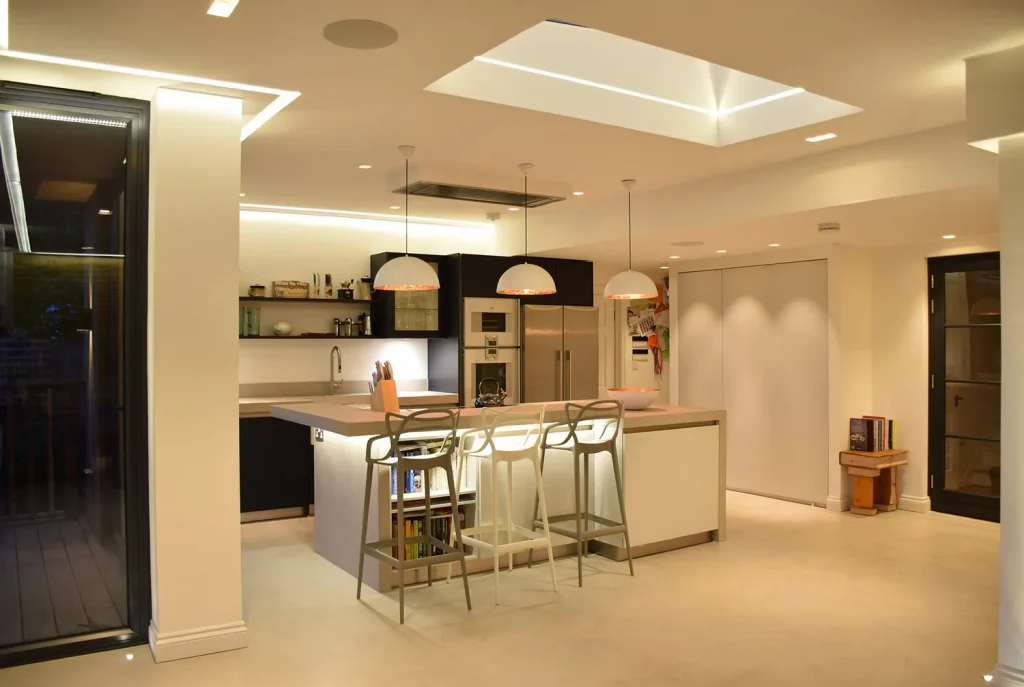
- Maximize natural light: Nothing beats sunlight—it’s free and healthy. Consider large windows, skylights, sheer curtains, or glass partitions to spread light without sacrificing privacy.
- Choose reflective materials: Glossy paint, large mirrors, glass, light-colored stone, or Barrisol stretch ceilings help bounce light and visually expand the space.
- Incorporate smart lighting: Use dimmers, motion sensors, or app-controlled systems to customize lighting by time, activity, or mood—enhancing comfort and energy efficiency.

- Embrace layered lighting: As noted above, aim for at least three layers of lighting in each room.
- Balance light and shadow: Not every corner needs to be lit. Intentionally placed dark areas create depth, mystery, and contrast—like a stage using light to guide the viewer’s eye.
7. Conclusion
Light is something you can’t physically touch, but it has the power to shape how you feel in a space—much like music creates emotion without words. Distributing light indoors isn’t just about installing bulbs; it’s about curating a visual experience, an emotional journey—where you can work efficiently, relax deeply, and enjoy beauty every day.
——
For further consultation, please contact Zegal Vietnam using the information below:
Zegal Hanoi
112 Vo Chi Cong, Nghia Do Ward, Cau Giay District, Hanoi
Zegal Ho Chi Minh
319 – C9 Ly Thuong Kiet, Ward 15, District 11, Ho Chi Minh City
Hotline: +84969 14 6688



